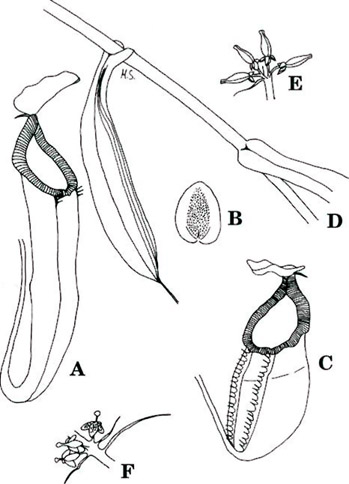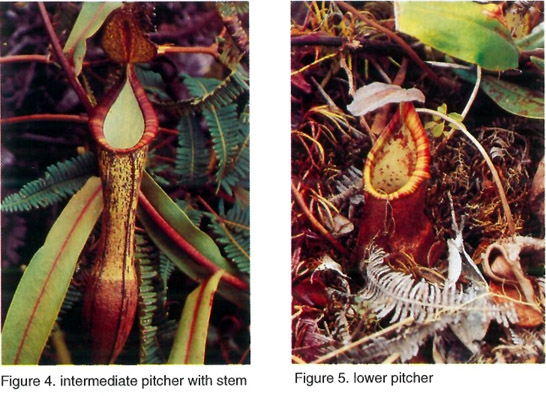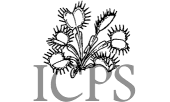Carnivorous Plant Newsletter
Volume 25, Number 4, December 1996, pages
106-111
Nepenthes lavicola,
a new species of
Nepenthaceae from the Aceh Province in the
North of Sumatra
Andreas Wistuba, Mannheim, Germany
Heiko Rischer, Magstadt, Germany
Summary:
A new species of Nepenthes ( Nepenthaceae) from Gunung Telong, Aceh province, Sumatra, Indonesia is described and illustrated.
Introduction:
On a field trip in 1996 we had the opportunity to climb and explore Gunung Telong, a mountain of volcanic origin near Gunung Geuredong. Both mountains are located in the area of Lake Tawar near the city of Takengon in the north of Sumatra.
In 1931 FREY - WYSSLING (p. 46) wrote about his exploration of the mountain and also mentions Nepenthes, though he could not determine the species. TAMIN and HOTTA (1986, p. 101) list the plant as Nepenthes singalana.
On the open slopes of Gunung Telong we observed a very distinct species of Nepenthes which is new to science and hence is formally described in this paper.
Nepenthes lavicola Wistuba et Rischer sp. nov.
Folia mediocria, lamina oblonga - spathulata, nervis longitudionalibus utrinque 5, basi cordata in alas 2 decurrente, caulem 2/3 amplectente; Ascidia rosularum mediocria, globosa-urceolata, alis 2 fimbriatis; peristomio versus acuminato et elevato, antice 1 mm, operculum versus 4 mm lato, costis 0,5 mm distantibus, dentibus 2x longioribus quam latis. Operculo ovato-cordato, facie inferiore plano. Ascidia superioria magna, parte inferiore infundibuliformi-ovata, parte superiore cylindrica, costis 2 prominentibus, peristomio versus acuminato et elevato, antice 2 mm, operculum versus 6 mm lato, costis 0,5 mm distantibus, dentibus 2x longioribus quam latis. Operculo ovato vel ovato-cordato, facie inferiore plano.
Inflorescentia racemosa, pedicellis 5 - 10 mm longis, fere omnibus 2-floris. Indumentum parcum villoso-tomentosum.
Holotypus : Wistuba et Rischer No. 26032, vine with pitchers and fruits, G. Telong, 2000 m alt., Aceh, Sumatra, 26.03.1996 (L).
Stems climbing, up to 3m high, the part with adult leaves 4 - 8 mm thick, triangular to quadrate, the internodes 3 - 6 cm long; at the base of older plants there are often short shoots.
Leaves of the short shoots oblong- lanceolate contracted into a linear base, 5 - 12 cm long and 2 - 3 cm broad, apically acumianate, clasping the stem for 2/3 circumference with the rounded base, pennate nerves indistinct, 3 longitudinal nerves originating from the basal 112 part of the midrib, running parallel in the outer 1/3 of the lamina, often indistinct in less developed leaves. Tendril 1 to 2 times as long as the leaf and without curl.
Leaves of the climbing stems thin coriaceous, oblong- lanceolate contracted into a linear base, 11 - 17 cm long and 2 - 4 cm broad, apically obtuse, clasping the stem for 2/3 of circumference with the cordate base, shortly decurrent, pennate nerves indis tinct, 5 longitudinal nerves originating from the basal 1/3 part of the midrib, running parallel in the outer 1/2 of the lamina, often indistinct in less developed leaves.Tendrils 1 - 1.5 times as long as the leaf, the pitcher bearing ones always with curl.
Pitchers of the rosettes abruptly originating, shortly incurved, short and wide, globose in the lower half to urceolate in the upper part, 5 - 7 cm long, 3 - 4 cm broad with two fringed wings over the whole length, the wings 2 - 3 mm broad, the fringe segments 3 - 5mm long, 1 - 2.5 mm apart, mouth almost horizontal in front,incurved towards the lid, elongated into a short neck, peristome flattened and 1 mm broad near the wing side up to 4 mm on the sides and near the lid, the ribs up to 0.5 mm apart, the teeth of the inner margin up to twice as long as broad, inner surface of the pitcher glandular in the lower half, glands overarched with about 200 per cm2 .
Lid ovate - cordate, the lower surface without appendage, glands ovate deepened, concentrated near the base.
Spur simple or bifurcate, 5 mm long, originating near the lid base.
Pitchers of the climbing stems abruptly originating from the hanging end of the tendril about 3 cm above the 1 - 2 cm wide curve, 11 - 16 cm long, slender, the basal part infundibuliform to ovate then ventricose 2 - 3.5 cm wide, slightly hipped in the middle narrowing to the somewhat waisted cylindrical upper part, the wings are reduced to ribs, rarely bearing few rudimentary fringes near the mouth.
Male inflorescence racemose, the peduncle 16 cm long, 5 mm thick at the base, the axis 20 cm long, pedicels mostly 2 flowered, 5 - 10 mm long, with 1 or 2 bracts, 5 - 10 mm long, narrow lanceolate, the lower part of the axis mostly bearing elongated bracts up to 3.5 cm long, tepals 3 - 6 mm long, elliptic, staminal column 3 mm long, the anthers included 3 - 5 mm long.
Female inflorescence racemose, the peduncle 20 cm long, 6 mm thick at the base, the axis 6 - 7 cm long, pedicels mostly 2 flowered, 8 -10 mm long, with 1 or 2 bracts, up to 1.5 cm long, narrow lanceolate, the lower part of the axis mostly bearing elongated bracts up to 7 cm long, tepals 4 - 6 mm long, elliptic, ovary sessile 4 - 5 mm long.
Fruit 2 - 3 times as long as broad, up to 1.8 cm long, valves up to 4 mm broad. Seeds filiform, 1.2 - 1.4 cm long.
Indumentum on the stems none, the leaves with an increasing pubescence on the lower side ofthe midrib towards the leaf tip, tendrils and young pitchers densely covered with short hairs, inflorescence except the tepals densely hairy.
Colour of herbarium specimen: light brown, colour of living specimen: pitchers usually dark brownish purple to almost black, peristome yellowish green, sometimes with red stripes, occasionally colour of pitchers yellowish green with blackish spots, interior surface of the pitchers pale green, in the lower pitchers red spotted.
Distribution and ecology:
The plant is very common on open slopes above 2000 m altitude up to the crater (about 2600 m) in volcanic soil of Gunung Telong near Takengon, Aceh province, Sumatra. The open slopes originate from volcanic activity in more recent times (1856) and the species probably grows in suitable habitats on the whole Gunung Geuredong massif (G. Geuredong, G. Telong, G. Popandji). No other Nepenthaceae were observed on Gunung Telong.
It is very remarkable that no other Nepenthes species is so far known growing further to the north in Sumatra than N. lavicola. DANSER (1928, p. 400) already doubted the restriction of Nepenthes to the southern three quarters of Sumatra.

Figure 1. Nepenthes lavicola Wistuba et Rischer
A. upper pitcher. B. lower side of lid. C. lower pitcher. D. part of climbing stem. E. seed capsules. F. part of male inflorescense with long bracts.


Notes:
In Table 1 we show some characteristics which clearly distinguish N. lavicola from N. spectabilis Danser and N. singalana Becc ., which seem to be related species. N. densiflora Danser also occuring in the Aceh province and N. junghuhnii nom. nud. exhibit characters which are less similar.
The epithet lavicola refers to the fact that this species was found growing on volcanic soil.
Table 1.
Characteristics of Nepenthes lavicola compared to the related Nepenthes spectabilis and Nepenthes singalana
|
Nepenthes lavicola |
Nepenthes spectabilis
|
Nepenthes singalana
|
Shape of lower pitchers
|
urceolate to globose
|
ovate in the lower part, cylindrical in the upper part
|
basal part infundibuliform, cylindrical in the upper part
|
Shape of upper pitchers
|
slender, lower part infundibuliform to ovate then ventricose, slightly hipped in the middle narrowing to the somewhat waisted cylindrical upper part
|
infundibuliform in the lower half, tubulose in the upper half
|
lower half infundibuliform, mostly ventricose in the middle, cylindrical or slightly narrowed towards the mouth
|
colour of the pitchers
|
usually dark brownish purple to almost black peristome yellowish green, sometimes with red stripes, occasionally colour of pitchers yellowish green with blackish spots. innerside of the pitchers pale green, in the lower pitchers red spotted
|
light green, with numerous longitudinal dark violett - brown stripes and spots
|
light green to dark red, violett spotted or not
|
lid |
ovate- cordate |
orbiculate |
suborbicular, cordate at the base
|
spur |
up to 0.5 cm in length, branched in case of lower pitchers
|
2 cm in length, simple
|
2 - 3 mm, slightly flattened, not branched
|
spur insertion |
close to the lid base
|
5 - 10 mm below
the lid base |
close to the lid |
floral bracts |
bracts very prominent, usually overarching the flowers, some of the lower ones reaching several cm in length
|
pedicels bearing filiform bracts
|
male: filiform bract female: without bract
|
fruit |
Fruit 2 - 3 times as long as broad, up to 1.8 cm long
|
very slender, 4-5 cm in length
|
up to 30 mm long |
Specimens examined:
Nepenthes lavicola : all specimens collected within a 100 m radius of N 4°46.031'/E 96°49.130'/2375 m alt. (according to GPS data).
Wistuba et Rischer No. 26032 (f), holotype, vine with pitchers and fruits, G. Telong, 2000 m alt., Aceh, Sumatra, 26.03.1996 (L); Wistuba et Rischer No. 26031 (m), vine with male flower, G. Telong, 2000 m alt., Aceh, Sumatra, 26.03.1996 (L); Wistuba et Rischer No. 26034 (f), vine with female flower, G. Telong, 2000 m alt., Aceh, Sumatra, 26.03.1996 (L); Wistuba et Rischer No. 26033 (0), climbing stem with intermediate pitchers, G. Telong, 2200 m alt., Aceh, Sumatra, 26.03.1996 (L); Wistuba et Rischer No. 26035 (0), short stem with lower pitchers, G. Telong, 2300 m alt., Aceh, Sumatra, 26.03.1996 (L).
Nepenthes densiflora: C. G. G-. J. van Steenis No. 8331 (f), isotype, Poetjoek Agoesan, biv. 1 tot 2, 2350 - 2400 m, 28.01.1937, H. L. B. 957.96.944 (L); (f/m)
H. L. B. 957.96.945 (L).
Nepenthes junghuhnii: Sumatra (s. loc.), Junghuhn s. n. (K).
Nepenthes singalana: Bunnemeijer No. 9997, G. Koerintji, alt. 2600 m, 04.05.1920, H.L.B. 928.350 - 169 (L); Meijer No. 3590, Mt. Sago, northern slope, open facies, mossy forest, Payakumbuh, 1800 - 1900 m, 29.06.1955 (L); Meijer No. 5841, Mt. Singgalang, surrounding of crater lake, subalpine veg., 2800 m, 26.05.1957 (L).
Nepenthes spectabilis: Lorzing No.7308 (f), type, G. Sibajak, 1800 - 1900 m, 05.06.1920, H.L.B. 928.350-170 (L).
Acknowledgements:
We would like to thank Dr. Jan Schlauer for his critical reading of this paper, Dr. Joachim Nerz for helpful general discussions about Nepenthes, Matthias Schmidt for preparing the illustration, Mr. Andi Adek from Padang, West Sumatra without whom many field trips to Nepenthes locations involving ourselves and Dr. Joachim Nerz, Boblingen, would hardly have been possible and the staff of the Rijksherbarium Leiden and Royal Botanic Gardens - Kew.
Literature:
Danser, B. H., The Nepenthaceae of the Netherlands Indies, Bull. Jard . Bot. Buitenzorg, Serie III. Vol. IX. Livr. 3 - 4 (1928)
Danser, B. H., A new Nepenthes from Sumatra, Bull. Jard . Buitenzorg, Serie III. Vol. XVI. Livr . 3: 268 - 271 (1940)
Frey - Wyssling, A., Over de vegetatie van den Boer ni Telong en omstreken in de Gajolanden ( Noord Sumatra), De Tropische Natuur, 20: 37 - 49, 1931
Tamin, R., & M. Hotta. 1986. The genus Nepenthes of the Sumatra Island. In: M. Hotta (ed.), Diversity and dynamics of plant life in Sumatra: 75 - 109. Kyoto.
|

